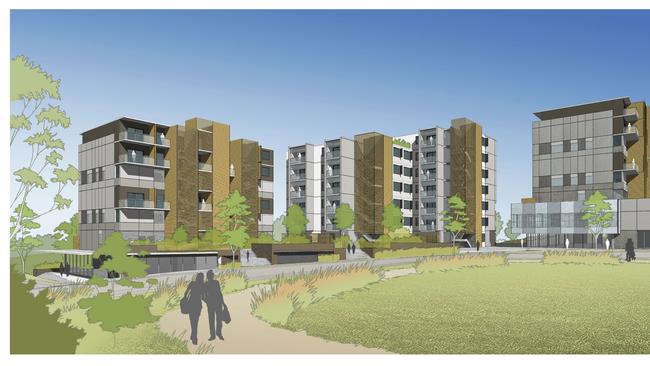Community housing providers – a new force in the residential sector
A new group of not-for-profits are set to become a major player in property and help address the housing crisis.

When it comes to residential development, names such as Frasers, Mirvac, Slattery and Stockland come to mind.
However, there is a growing group of Community Housing Providers such as Brisbane Housing Company, BlueCHP, Bridge Housing, CHC Australia, Community Housing, Hume, Housing Choices, Link Wentworth and SGCH to name a few that are becoming major players in the residential sector.
CHPs may be the missing piece in the puzzle to provide homes at scale for vulnerable Australians.
They are increasingly well-placed to attract more investment into the sector and, most importantly, deliver much-needed accommodation.
CHPs are not-for-profit organisations and registered charities that build and/or manage homes for people on low to medium incomes who may not otherwise be able to access suitable accommodation. Many CHPs also offer housing for specific cohorts, such as properties for Aboriginal and Torres Strait Islander peoples, older women at risk of homelessness, families escaping from domestic and family violence, veterans, and specialist disability accommodation.
CHPs operating in all states and territories except for Victoria and Western Australia are regulated by the National Regulatory System for Community Housing.
NRSCH-registered providers are required to meet certain standards and regulations to ensure that they are well governed, well managed, and are able to provide safe and suitable housing for their tenants. These standards cover areas such as tenant rights and responsibilities, financial management, governance, and service delivery.
CHPs are registered under the NRSCH in one of three categories – Tier 1, Tier 2, and Tier 3 – depending on the size and complexity of their operations. Tier 1 providers have the expertise to buy and develop assets along with complex tenancy and property management functions.
According to the NRSCH, as at June 30, 2022, there were 312 registered CHPs that own or manage more than 103,000 community housing assets. Of these, 41 are Tier 1 providers, 42 are Tier 2 providers and 299 are Tier 3 providers.

While the majority of CHPs operate in specific areas, 25 NRSCH-registered providers responsible for 34,000 community housing assets operated in more than one jurisdiction, with 15 of those providers operating in another NRSCH jurisdiction only. Additionally, there are ten providers who are registered under the NRSCH but also have properties in Victoria and/or Western Australia.
Due to the sector’s charitable status, CHPs are exempt from income tax, GST, land tax and stamp duty, enhancing their ability to make its development projects stack up.
The community housing sector has experienced significant growth over the past decade. This growth has been driven by the sector willing to partner with federal and state governments and institutional investors. The transfer of public housing dwellings from state and territory housing authorities to CHPs has helped to improve the efficiency and effectiveness of social and affordable housing delivery. In the past five years, more than 21,000 dwellings have been transferred to CHPs.
Furthermore, the National Housing Finance and Investment Corporation, which was established by the federal government in 2018, has played an important role in establishing social and affordable housing as an attractive asset class for institutional investors.
NHFIC has approved more than $3.4bn in low-cost, long-term loans to 39 CHPs, supporting more than 17,500 new and existing homes. Additionally, these loans have saved CHPs an estimated $629m in interest and fees, as well as other indirect costs associated with refinancing over the life of the loan. The long duration of these loans means the CHPs that accessed NHFIC funding can ride through the current interest rate cliff.
NHFIC has also issued more than $2.2bn in bonds via six bond issuances with tenors up to 15 years.
This has helped to leverage institutional capital into the sector.
As part of the federal government’s housing policy, NHFIC will be renamed Housing Australia and will have primary responsibility for delivering 30,000 social and affordable homes under the Housing Australia Future Fund and 10,000 homes under the National Housing Accord.
As interest rates rise at the fastest pace in more than a decade, and rents rise across the country, housing stress among low-income households is worsening.
A common measure of rental stress is to look at the proportion of lower income households paying more than 30 per cent of their income on housing costs.
According to a recent report by SGS Economics and Planning, 42 per cent of all low-income households are paying more than 30 per cent of their income on housing. This rises to 47 per cent for households in NSW and 58 per cent for Australia’s private rental market.
The CHP sector therefore has a vital role to play in helping to address this housing crisis. So how will this play out?
CHPs will increasingly look to partner with government at all levels and organisations such as institutional investors, private developers, and church-based groups to develop affordable housing.
These partnerships will allow for the combination of land, funding, development expertise, and skills. No one group can go alone. By bringing together these components, the supply pipeline of social and affordable housing can be fast-tracked.
As confidence grows in the CHP sector’s capability, institutional investors looking to invest in social and affordable housing are now seeking direct partnerships with CHPs, rather than solely investing in the sector through NHFIC’s social bonds.
One notable example of this is SGCH’s recent partnership with AXA IM Alts, a global investment firm with $285bn in funds under management. The partnership aims to develop and own sustainable, high-quality, and affordable new homes for the long term. NHFIC is providing a $300m umbrella facility to support the delivery of social and affordable housing through this partnership.
SGCH has also entered into two agreements with Lighthouse Infrastructure, an Australian based investor which is providing $120m for key worker housing.
Australian Retirement Trust, one of Australia’s largest superannuation funds, has partnered with QIC, and Brisbane Housing Company, a leading CHP, to finance new social and affordable housing supply in Queensland. This partnership has developed an innovative, scalable model for the financing, development and operation of social and affordable housing.
Some CHPs have limited organisational capacity and capability to undertake development, and as the superannuation sector is finding, there are significant benefits in terms of economies of scale from mergers.
With more than 300 CHPs, the sector is ripe for consolidation. Not all CHPs will or should merge, as many offer very specialised services in particular locations.
However, to ensure that they have the right skills (board, senior management and specific project and delivery management) and systems and processes, some consolidation will need to occur.
CHPs will also be attractive to developers and managers of “build to rent” projects. These groups typically don’t have the skills and expertise to provide tenancy management services to tenants in the social and affordable components of their mixed tenure developments.
Access to quality accommodation is an essential aspect of a healthy and prosperous society. Housing is a fundamental human need, and ensuring that everyone has access to safe, secure, and affordable housing is a critical goal for our nation.
The CHP sector is set to become a major player in the residential sector and, in doing so, play a key role in addressing the housing crisis.
Adrian Harrington is chair of the National Housing Finance and Investment Corporation and interim CEO of Summer Housing. The views expressed in this article are those of the author and do not necessarily reflect the views or positions of NHFIC or Summer Housing.





To join the conversation, please log in. Don't have an account? Register
Join the conversation, you are commenting as Logout